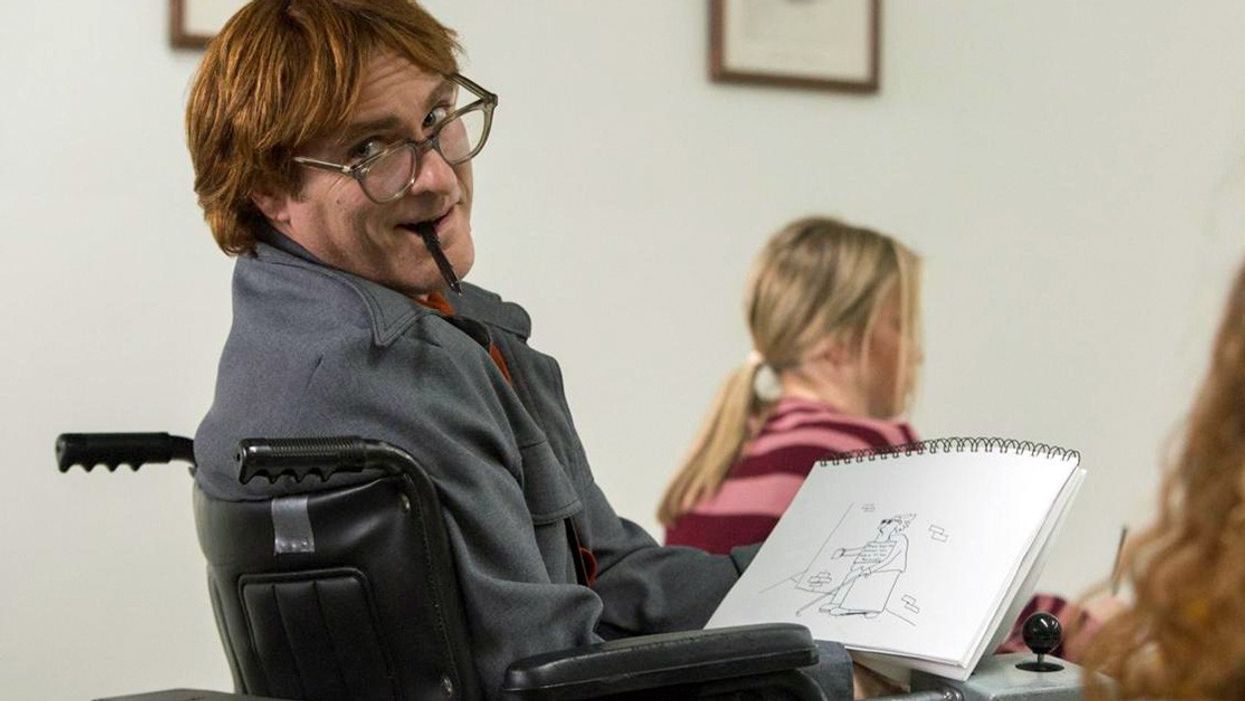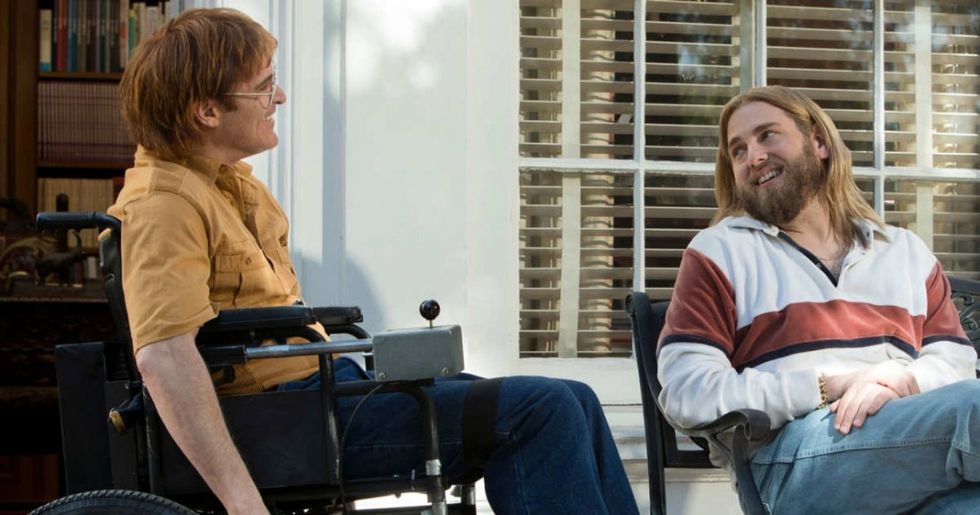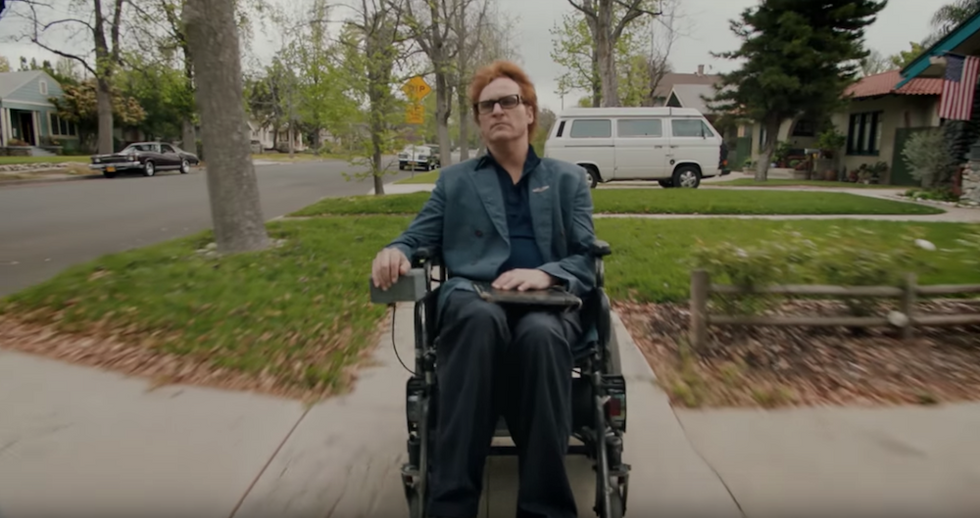How Gus Van Sant's Latest Film Tells Five Periods of a Life at Once
For 'Don't Worry, He Won't Get Far on Foot', Gus Van Sant's priority was assembling the divergent parts of John Callahan's life.

The accident that looms behind Gus Van Sant’s newest film, a drunken car crash that turns John Callahan from a fun-loving alcoholic into a permanent quadriplegic, would be enough to slow the speed of many films, but not this one. Don’t Worry, He Won’t Get Far on Foot, adapted from Callahan’s memoir, pounds along with considerable energy and admirable complexity. Featuring consistently surprising performances from Joaquin Phoenix as Callahan, along with Jonah Hill, Mara Rooney, Jack Black, and many others, the film teaches us about the process of artistic survival as much as physical survival. As Callahan goes through the process of AA and then group counseling, his art flourishes as he finds inner repositories of understanding he may not have known he had.
The film premiered at Sundance 2018 and is now out in US theaters, following a long line of celebrated films from the director including Drugstore Cowboy, My Own Private Idaho, and Good Will Hunting. No Film School talked to Van Sant, independent film adventurer, about the steps he tool in composing this latest remarkable story.
No Film School: How did you develop the pacing for this film? To me it seems like a narrative of recovery, and often those stories have a natural rise and fall—this movie, though, moves along at a rapid pace.
Gus Van Sant: I think it started that way in the screenplay. I was trying to tell about these five time periods from different sections of [Callahan's] life. I limited it to five, but I think in the book there’s probably about a hundred different periods—we narrowed it down. So we were sort of juggling those different time periods as they related to each other. One was his existence as an experienced quadriplegic and cartoonist at the end, when he’s seen with the crowd and he’s talking with the skateboarders, and then the earlier part, the day of his accident, when he can still walk, is another period. And then his physical recovery was a whole period, and then his alcohol recovery, separately, was a period, and then the fifth one would be his cartooning and the eventual activity that he ended up doing for the rest of his life.
NFS: How did that separation assert itself in the way the film was edited?
Van Sant: Each thing was sort of commenting on the other. The cartooning was commenting on his drinking, and the drinking was fueling the cartoons, and his later experience as a cartoonist was fueled by the accident and drinking and recovery and his recovery was grinding it together in his life story that he told the group. It’s all kind of interrelated, as you’re cutting back and forth between the periods.

NFS: On the subject of cartooning, how did you handle the drawing scenes? Were those Joaquin Phoenix’s hands?
Van Sant: Very rarely, but sometimes, it was Joaquin’s hands, but we had two artists doing that. One was a member of the production design department, and one was my assistant, who is a painter. They had different kinds of command over doing John Callahan-style drawings. One could make up new characters, and one of the artists could do already existing Callahan characters. We were filming both guys super close, so you couldn’t see whose hand it was.
NFS: The film is wonderfully cast, down to the last person. Phoenix seems like a natural for the lead because he so often plays wounded characters. How did Jonah Hill come to be cast?
Van Sant: He was someone I met in New York. I was staying at the Bowery Hotel, and he just came up to me in front of the hotel and said he knew my work and he was a really big fan and wanted to work together. So, much later, we were looking for somebody to play the part, and I remembered Jonah had also done a lot of serious work as well as comedic work, and so we considered him. By the time we were making our film, he had accomplIshed a lot, so I remember asking Joaquin if he thought Jonah would be good, and he said, "Yeah, he can do anything, he’s perfect." At first he said no, after we sent him the script, but then it took us a year to cobble together the financing, and then, after we finished securing the financing, he said yes.
"One thing we thought is that we should see what Jonah Hill would look like if he had Tom Petty’s hair."
NFS: What was his process?
Van Sant: His hair was something that was in the script. John had written that [Hill's character] Donnie was “rocking that Tom Petty look.” I think that was something that jumped out at Jonah, because it was something he had never played—Tom Petty. So the first thing we thought was that we should see what he looked like if he actually had Tom Petty’s hair, to see if it looked believable. So we did a little test, at my house, with a relatively inexpensive wig, and it looked good. Then we got the professionals involved. Also, he thought of the character as powerful in the face of the group, and he related that to people he knew in his life who were powerful but did not talk with a loud voice, sort of like Don Corleone.

Van Sant: I guess I relate to it like this: when you’re young, you’re adrift, and then you find a way, a direction. It’s also a convention to have a direction the story is taking you and taking the character, from one part to another part, as in a Greek story, like the Odyssey—that journey.
NFS: I found myself thinking about free will a lot when I was watching the film. Because there’s a lot of discussion in the film of surrendering yourself to a higher power in recovery, and yet Callahan empowers himself with his drawing. What importance do you think free will had in his life?
Van Sant: There was one thing we were trying to do in the script and in the finished film, as we were editing. It seemed like one of the strong elements of the story is someone asking for help—in Jonah’s case, asking Donnie to be his sponsor. Even though he distrusts the advice at times, he still needs to think about it. It slowly helps him. With Donnie’s advice and the group’s suggestions, it helps him. There’s something really powerful about asking for help, and receiving help.
"When you’re young, you’re adrift, and then you find a way, a direction."
NFS: How do you think the cartoons play into that?
Van Sant: This is a little part of the story that’s not explained, but he was an artist before the accident. When he had more time, when he wasn’t just busy getting drunk, he went back to school, and in school, he realized it was enjoyable to try to make people laugh with his cartoons. We’re not really explaining it the way the book does, but in the book, he says it overtook him really quickly. He was really just trying to make a girl in class laugh. Every week he would make a cartoon to make this one girl in the class laugh, and then that turned into showing the cartoons to other people and making them laugh, and so, sort of like a comedian, he got addicted to laughter, to the point where all he did was try to think up cartoons, and it was so all-encompassing to him that he even wondered at one point why everyone on the planet wasn’t drawing cartoons. That was what he did, and he did that for a number of years.











